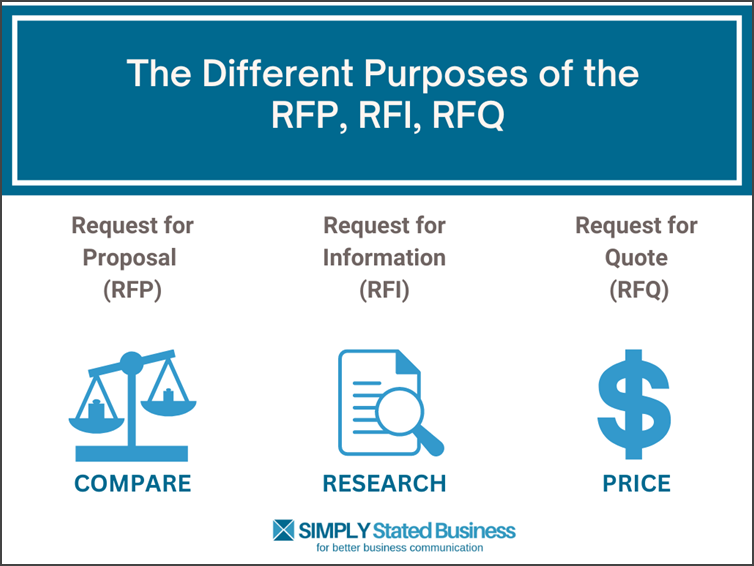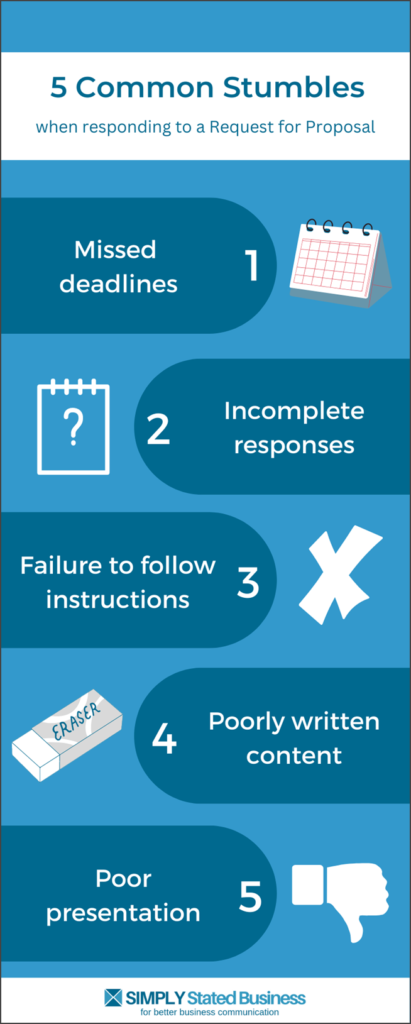
Jennifer follows the information technology department of Martens Products. She has been tracking them for what seems forever.
While doing her weekly status check, Jennifer sees the company’s site has a Request for Proposal (RFP) for a new project. Eureka! One problem. Jennifer has never completed an RFP.
- Are you like Jennifer?
- Does responding to a company’s RFP fall into your lap?
- Do you know what an RFP is?
Your response could mean the difference between a sale or wasted energy.
This post reviews how to respond to an RFP. A future post examines how to create one.
What is a Request for Proposal
The Request for Proposal is the formal document used to gather bids on a project. Government agencies and businesses both use the document. Typically, it includes the following.
- Project details, including project goals
- An outline of the bidding process and the basis for evaluation
- In-depth questions regarding the vendor’s capabilities
- Timelines for completion
Some view a formal Request for Proposal as an archaic tool, similar to their negative view of white papers. Yet, both still exist. Like most business tools, both have evolved.
Relatives of the Request for Proposal
Businesses may use other forms of requests than the formal proposal. And, of course, each has its own acronym.
Request for Proposal (RFP) – This is the granddaddy of requests. It is the detailed questionnaire used to compare vendors to select one to fulfill the current needs of the business.
Request for Information (RFI) – The RFI helps gather vendor product and service information. It’s often used as a research tool to get a handle on the market and may be sent prior to the full-fledged RFP.
Request for Quote or Quotation (RFQ) – The cut-to-the-chase document obtains the vendor’s detailed pricing for the specific needs provided by the sender of the questionnaire.
Want a quick way to remember the difference? Picture the illustration below: Compare – Research – Price.

For purposes of this post, the focus is on the hefty RFP document.
5 RFP Stumbles
Even if the RFP you receive is not a formal one, the stumbling blocks remain the same. Illustrated below are the 5 most common stumbles when preparing a response to the RFP.

An earlier post, How Bad Communication Lost $60 Million, shared how costly those stumbles can be. The following is a simple checklist to help avoid costly mistakes when responding.
Your RFP Checklist
The checklist is divided into three stages.
- Tasks
- Review
- Delivery.
#1 Tasks
First, assemble your team who will be working on the response. If that’s just you, assembly should be easy. 🙂
- Assign tasks – you may divide the RFP into sections or assign specific questions.
- Establish deadline for completion – each task should have a deadline (in addition to those cited in the RFP).
Allow sufficient time for review and delivery when assigning tasks and deadlines. In the ideal world, an individual assigned to project management has responsibility for overseeing the entire process.
#2 – Review
A subject matter expert should review each response. Larger companies have the luxury of assigning subject matter experts skilled in areas such as proofreading, technical editing, and sales and marketing.
Again, if you fly solo, focus on each area separately so you don’t miss any. Ask the following questions.
Are the individual responses accurate?
Confirm what you say you can do and how you do it is accurate. Trust me, embellishing your capabilities will only backfire. If rewarded the project, do you really want to explain to your new client why you lied?
Don’t skip the mechanics of review.
- Check for typos, grammatical errors, spell check
- Verify statistics, cross-references
- Review formatting – page numbers, style
Did the response answer the question?
I cannot tell you how many times the responder fails to answer the question. The reason is often because they use canned responses to RFPs and, frankly, got lazy.
RFPs are labor-intensive so having prepared responses makes good sense. But beware of too much cut and paste action that omits a critical answer to a question.
Did every question get answered?
While not every question may apply to your business, it is important to provide a response to each question. Why?
- Responding to each question demonstrates your attention to detail.
- You are less likely to skip a question you intended to reply to.
- The buyer may use a digital screening process that automatically eliminates bids that skipped questions.
If the question does not apply, offer a brief explanation as to why.
The final stage is the delivery.
#3 – Delivery
This stage includes the assembly and delivery of the final product.
- Verify staff has the final version of all responses.
- Follow RFP instructions regarding layout, assembly, and delivery.
- Confirm the requested number of copies for delivery.
- Ensure staff has all attachments and supplements.
- Determine method of delivery to ensure compliance with RFP deadline.
Download free checklist template
What’s a checklist without, well, a checklist? Download this one-page pdf document: A Request for Proposal (RFP) Checklist for Responders.
What suggestions would you add for responding to RFPs? Share your tips in Comments.
Note: This post originally published on October 24, 2012. This May 8, 2023 version updates it.
==================================
Helping you keep your business communication simple, clear, and uniquely yours.
==================================

The one thing I can’t stress enough is to proofread, then proofread again. If your responses contain typos, your prospects will assume that’s the level of quality you’re going to deliver. So proofreading your RFP response is an easy way to separate yourself from the competition.
Hi Dave. Thanks for your thoughtful comments. I handled a LOT of RFPs in my corporate days. One typo that was common and a real killer was forgetting to change the name of the prospect when using an RFP template. Ouch.
Thanks for stopping by, Dave.
Ouch, that is the worst! And that RFP instantly goes in “File 13.”
You bet it does, Dave. Oh, the stories I could tell. Of course, I never screwed up. 😉
Actually, this list can also apply to any proposal, not just an rfp.
I would imagine that’s true, Anne. Organization is organization, right? 😉